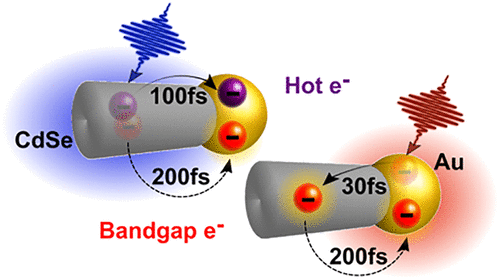当前位置:
X-MOL 学术
›
Nano Lett.
›
论文详情
Our official English website, www.x-mol.net, welcomes your
feedback! (Note: you will need to create a separate account there.)
Visualizing Ultrafast Electron Transfer Processes in Semiconductor–Metal Hybrid Nanoparticles: Toward Excitonic–Plasmonic Light Harvesting
Nano Letters ( IF 9.6 ) Pub Date : 2021-01-22 , DOI: 10.1021/acs.nanolett.0c04614 Franco V. A. Camargo 1 , Yuval Ben-Shahar 2, 3 , Tetsuhiko Nagahara 1, 4 , Yossef E. Panfil 2 , Mattia Russo 1 , Uri Banin 2 , Giulio Cerullo 1
Nano Letters ( IF 9.6 ) Pub Date : 2021-01-22 , DOI: 10.1021/acs.nanolett.0c04614 Franco V. A. Camargo 1 , Yuval Ben-Shahar 2, 3 , Tetsuhiko Nagahara 1, 4 , Yossef E. Panfil 2 , Mattia Russo 1 , Uri Banin 2 , Giulio Cerullo 1
Affiliation

|
Recently, it was demonstrated that charge separation in hybrid metal–semiconductor nanoparticles (HNPs) can be obtained following photoexcitation of either the semiconductor or of the localized surface plasmon resonance (LSPR) of the metal. This suggests the intriguing possibility of photocatalytic systems benefiting from both plasmon and exciton excitation, the main challenge being to outcompete other ultrafast relaxation processes. Here we study CdSe-Au HNPs using ultrafast spectroscopy with high temporal resolution. We describe the complete pathways of electron transfer for both semiconductor and LSPR excitation. In the former, we distinguish hot and band gap electron transfer processes in the first few hundred fs. Excitation of the LSPR reveals an ultrafast (<30 fs) electron transfer to CdSe, followed by back-transfer from the semiconductor to the metal within 210 fs. This study establishes the requirements for utilization of the combined excitonic–plasmonic contribution in HNPs for diverse photocatalytic applications.
中文翻译:

可视化半导体-金属杂化纳米粒子中的超快电子转移过程:向激子-等离子体光收集
最近,证明了在对金属进行半导体或局部表面等离振子共振(LSPR)的光激发后,可以在杂化金属-半导体纳米粒子(HNP)中实现电荷分离。这表明光催化系统同时受益于等离激元和激子激发的巨大可能性,其主要挑战是与其他超快弛豫过程竞争。在这里,我们使用具有高时间分辨率的超快光谱研究CdSe-Au HNP。我们描述了半导体和LSPR激发的电子转移的完整路径。在前者中,我们区分了前几百fs的热和带隙电子转移过程。LSPR的激发表明超快(<30 fs)电子转移到CdSe,然后在210 fs内从半导体反向传输到金属。这项研究建立了在各种光催化应用中利用HNP中的激子-等离子组合贡献的要求。
更新日期:2021-02-10
中文翻译:

可视化半导体-金属杂化纳米粒子中的超快电子转移过程:向激子-等离子体光收集
最近,证明了在对金属进行半导体或局部表面等离振子共振(LSPR)的光激发后,可以在杂化金属-半导体纳米粒子(HNP)中实现电荷分离。这表明光催化系统同时受益于等离激元和激子激发的巨大可能性,其主要挑战是与其他超快弛豫过程竞争。在这里,我们使用具有高时间分辨率的超快光谱研究CdSe-Au HNP。我们描述了半导体和LSPR激发的电子转移的完整路径。在前者中,我们区分了前几百fs的热和带隙电子转移过程。LSPR的激发表明超快(<30 fs)电子转移到CdSe,然后在210 fs内从半导体反向传输到金属。这项研究建立了在各种光催化应用中利用HNP中的激子-等离子组合贡献的要求。











































 京公网安备 11010802027423号
京公网安备 11010802027423号